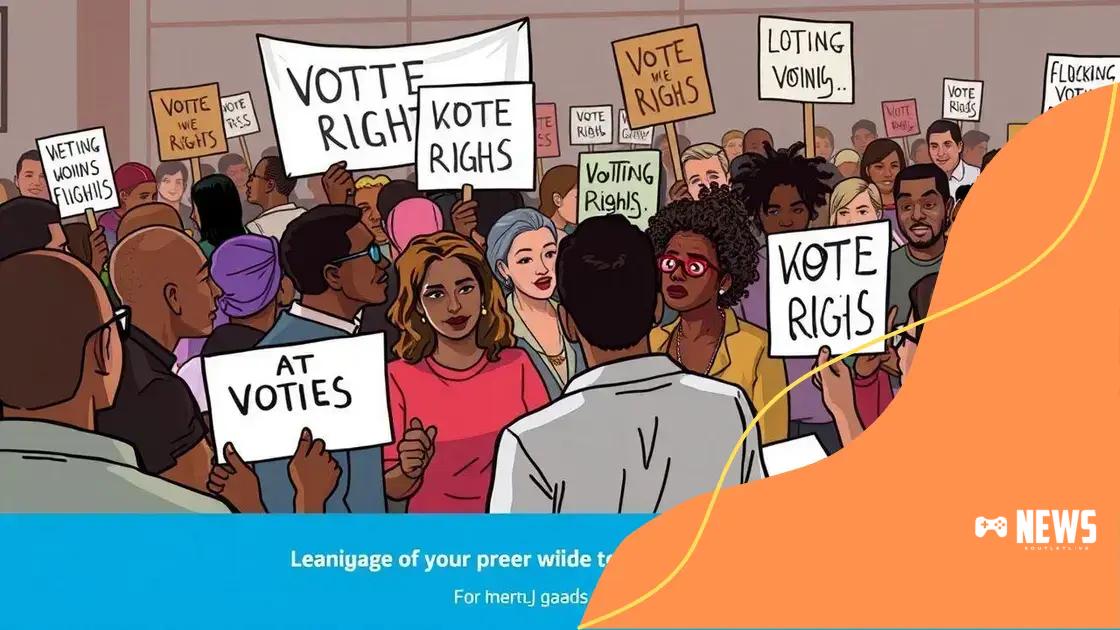Voting rights legislation debates: uncovering the truth

Voting rights legislation debates involve discussions on key laws that impact access to the ballot, including voter ID requirements, mail-in voting, and state-level initiatives aimed at enhancing or restricting voter participation.
Voting rights legislation debates are more than just political discussions; they shape how citizens engage in democracy. Have you wondered how changes in laws can affect your right to vote?
Understanding the evolution of voting rights in the U.S.
The evolution of voting rights in the U.S. is a fascinating journey marked by struggle and triumph. From the founding days to the present, the fight for fair representation has shaped the nation.
In the early years, voting rights were limited, mainly to white, land-owning men. Changes slowly began as people recognized that a true democracy should include a wider range of voices.
The Key Amendments
Several crucial amendments to the Constitution have transformed voting rights.
- The 15th Amendment prohibited denying the right to vote based on race, though many barriers still existed.
- The 19th Amendment granted women the right to vote, expanding the electorate significantly.
- Later, the Voting Rights Act of 1965 addressed inequalities, aiming to enforce the voting rights guaranteed by the 14th and 15th Amendments.
As society evolved, so did the understanding of voting rights. Activists, such as Martin Luther King Jr. and suffragists, played a vital role in pushing for change. Their passion and determination led to significant advancements, ensuring that more citizens could participate in the democratic process.
However, the battle continues. Recent debates about voting laws highlight ongoing challenges and the need for vigilance. Today, discussions focus on issues like voter ID laws and disenfranchisement, reminding us that safeguarding the right to vote remains essential.
Key legislation affecting voting rights
Understanding the key legislation affecting voting rights is crucial for grasping the changes in how Americans exercise their franchise. Throughout history, specific laws have played significant roles in shaping the electoral landscape.
Voting Rights Act of 1965
This landmark legislation aimed to eliminate racial discrimination in voting. It outlawed practices like literacy tests and provided federal oversight in areas with a history of voting discrimination. The act significantly increased voter registration among African Americans, especially in the southern states.
National Voter Registration Act of 1993
Commonly known as the Motor Voter Act, this law allowed citizens to register to vote when applying for or renewing a driver’s license. It sought to simplify the registration process and increase participation in elections.
- It required states to offer voter registration by mail.
- It mandated that states maintain the accuracy of voter registration lists.
- It aimed to ensure that all eligible citizens could register to vote easily.
The Help America Vote Act of 2002 was another significant step, especially after the issues seen in the 2000 election. This legislation provided funding for states to enhance their voting systems, including better technology and training for poll workers.
In recent years, various state laws have emerged, some aiming to tighten voting requirements. Laws requiring photo identification and limiting mail-in voting have sparked intense debates. Advocates argue these laws protect election integrity, while opponents claim they suppress voter turnout among marginalized groups.
As the landscape of voting rights continues to evolve, staying informed about key legislation is essential. Each law reflects a broader struggle for inclusion and representation in the democratic process.
Impact of recent voting rights debates

The impact of recent voting rights debates has been significant, affecting how elections are conducted across the United States. These debates often focus on various measures that some believe secure elections while others see as voter suppression.
Voter ID Laws
One major issue in voting rights discussions is the implementation of voter ID laws. Proponents argue that these laws prevent fraud and strengthen election integrity.
- Supporters believe photo identification is essential for verifying voter identity.
- Many states have enacted laws requiring IDs to vote.
- Critics argue these laws disproportionately affect minorities and low-income individuals who may lack acceptable IDs.
Another heated topic is the accessibility of mail-in voting. During the COVID-19 pandemic, many states expanded mail-in voting to ensure everyone could participate safely. However, some recent debates have sought to limit mail-in ballots, claiming vulnerabilities to fraud.
These changes have caused divisions, with early voters urging for more accessibility while state legislators push for restrictions. Additionally, the push for automatic voter registration has gained momentum, aiming to simplify the registration process and increase voter participation.
Future Considerations
The ongoing discussions around these issues signify an essential battle for the heart of democracy. The debates are shaping policies that could define how future elections evolve, preserving or challenging the electoral rights of countless citizens. As these discussions continue, it is critical for voters to remain informed and engaged.
State-level initiatives and their implications
State-level initiatives related to voting rights often reflect the unique political climates and demographics of each state. Recently, several states have enacted laws aimed at either expanding or restricting access to the ballot, leading to varied implications across the country.
Expansion of Voting Access
Some states have pursued initiatives to increase voter participation. These efforts include implementing automatic voter registration and extending early voting periods. Such measures aim to make the voting process more accessible to everyone.
- Automatic registration helps ensure eligible voters are signed up without requiring additional action.
- Extended early voting allows people more opportunities to cast their ballots.
- States like California and New York have implemented these ideas to boost turnout.
Moreover, states have also expanded mail-in voting options, especially following the COVID-19 pandemic. This expansion can lead to higher election participation among those who may struggle to vote in person due to health or logistical issues.
Restrictions and Challenges
Conversely, some states have introduced measures that restrict voting access. This includes laws requiring strict voter ID, limiting mail-in ballot use, and reducing early voting hours. Proponents argue that these laws are necessary to maintain election integrity.
- Supporters claim strict ID laws help prevent voter impersonation.
- Critics argue that these restrictions disproportionately affect minority groups and low-income individuals.
- Such laws can create significant challenges for voters trying to navigate complicated registration and identification requirements.
The implications of these initiatives are profound. They not only affect who can vote but also shape how and when people participate in the electoral process. As states continue to adopt different measures, the national landscape of voting rights remains in flux, reflecting ongoing debates about democracy and access.
Future directions for voting rights advocacy
Future directions for voting rights advocacy are shaped by ongoing challenges and emerging opportunities. As society evolves, so must the strategies that advocates use to ensure fair and equitable access to the ballot.
Embracing Technology
One significant area of focus is the use of technology to improve voter access and engagement. Innovations such as online voter registration and mobile voting apps are gaining traction. These tools can help reach younger voters who prefer digital solutions.
- Online registration can simplify the process for many, making it easier to participate.
- Mobile apps for voting information can educate voters about their rights and upcoming elections.
- New technologies can streamline ballot counting and security measures, increasing trust in electoral processes.
Moreover, leveraging social media campaigns can mobilize support and inform the public about crucial issues. This approach helps to raise awareness and build coalitions among diverse groups.
Building Coalitions
Collaboration between different advocacy groups is essential for success. By working together, organizations can amplify their voices. This can lead to more significant impacts on legislation regarding voting rights.
- Coalitions can help share resources and combine efforts in lobbying efforts.
- Diverse groups can address broader issues that intersect with voting rights, such as education and economic justice.
- Cross-state coalitions can tackle local and national barriers against voting access effectively.
As debates continue about voter ID laws and mail-in voting, advocacy groups must remain vigilant. Educating communities about their rights and the importance of participation is key. Grassroots movements can also drive change from the bottom up, ensuring that every voice is heard. Advocacy for voting rights is an ongoing journey, adapting to new challenges and opportunities that arise.
FAQ – Frequently Asked Questions about Voting Rights Advocacy
What is the importance of voting rights advocacy?
Voting rights advocacy ensures that all citizens have equal access to the ballot, which is essential for a healthy democracy.
How can technology help improve voter access?
Technology like online registration and mobile voting apps can simplify the voting process and engage younger voters.
What are some common initiatives aimed at expanding voting rights?
Common initiatives include automatic voter registration, extended early voting periods, and increased mail-in voting options.
Why is coalition-building important in voting rights advocacy?
Coalition-building strengthens advocacy efforts by uniting diverse groups, allowing for a more significant impact on legislation regarding voting rights.





